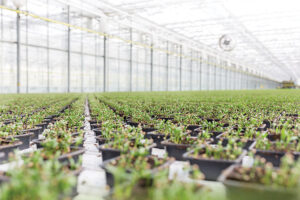
Technically Speaking: Controlling greenhouse temperature for successful production
The single greatest reason we grow crops inside greenhouses is to regulate the temperature. In addition, the primary determinant of crop timing is the average temperature. Despite this, it can be easy to overlook temperature and focus on greenhouse crop production challenges, especially ones that create obvious plant symptoms. In this article, I discuss the fundamentals of greenhouse temperature and why its management is so critical to success.
Temperature controls crop production time
All plants have the same general response to temperature: they develop faster at high temperatures and slower at low temperatures. What does vary from one crop to another is what constitutes a high or low temperature. We have categorized crops based on research that has estimated the base temperature for each. The base temperature is the low temperature below which plants stop developing. “Cold-tolerant plants” are those with base temperatures of 39° F or lower and “cold-sensitive plants” are those with base temperatures of 46° F or higher.

Seemingly small differences in base temperature can have surprisingly large effects on crop production time. For example, lowering the average daily temperature from 68° F to 62° F delayed time to flower of the cold-sensitive crop angelonia by 16 days, but the delay in flowering of the cold-tolerant crop snapdragon was only five days. These values will depend on the maturity of the plug at transplant as well as average daily light integral, but the relative effect of temperature on flowering does not change.
For more information on the effects of temperature on flowering time for a wide range of crops, download the FlowersOnTime grower tool under the “Grower resources” tab at floriculturealliance.org. Production time information specific to Wave petunia is online at panamseed.com/ northamerica/brands/wave/smartschedule.
Temperature influences crop heating costs
When it’s cold outside, energy consumption for heating increases as the greenhouse temperature setpoint increases. It can be tempting to lower temperature setpoints to decrease energy costs on a daily basis, but that also delays flowering, which can be counterproductive.
The online tools listed above can be used to gauge the effect of decreasing (or increasing) temperature on flowering time. Virtual Grower, available at virtualgrower.net, can estimate the effect of changing the temperature on greenhouse heating costs, among many other uses. It is a powerful tool that can help growers make more informed decisions on how to manage temperature based on energy consumption as well as crop timing.
Temperature influences relative humidity
The temperature of the air influences the amount of water vapor it can hold. Specifically, the water-holding capacity of air decreases with temperature, which means that relative humidity goes up as temperature goes down. Except during propagation, a high humidity (less than 80-85% relative humidity or greater than 0.5 kPa vapor-pressure deficit) should generally be avoided, especially at night. When making temperature decisions, don’t ignore its effect on humidity, especially when a greenhouse is full of plants. High humidity decreases water and nutrient uptake by plants, which can slow down growth and can create more favorable conditions for pathogens.

Day/night temperature regulates crop height
For most crops, a warmer day than night temperature (positive DIF, or +DIF) promotes stem extension and subsequently crop height. The opposite is true too; plants are more compact when the day is cooler than the night (negative DIF, or –DIF). There are trade-offs to a –DIF for compact growth as energy costs for heating are typically higher and other quality attributes may be marginally lower. Regardless, when choosing greenhouse temperature settings, consider how the difference between the day and night temperature will impact crop height.
Successful delivery of temperature setpoints
There are many factors that influence how well the greenhouse temperature setpoint is achieved, especially when the outside temperature is high. Factors that can hamper attaining your setpoint in an energy efficient manner include:
- Gaps or tears in the glazing or sidewalls
- Doors left open to the outside or growing area at a different temperature
- Side and/or roof vents do not completely close or adequately open
- Exhaust fans are not working properly
- Evaporative pads are not fully functional
- Fog or fine-mist nozzles are clogged
- Air temperature sensors are not aspirated or sufficiently close to the crop
- There is an inadequate dead band between when heating turns off and ventilation begins, and vice versa.
Considering the importance of temperature on plant growth, flowering time and energy consumption, it’s critical that setpoints are chosen based on a variety of factors including those mentioned here. In addition, greenhouses need to be sufficiently maintained so that desired setpoints are achieved as closely as possible.
For more on greenhouse temperature management, visit Michigan State University’s website, which offers “Greenhouse temperature management” resources.









 Video Library
Video Library 


















